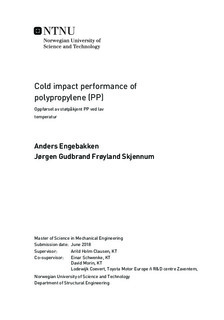Cold impact performance of polypropylene (PP) - Oppførsel av støtpåkjent PP ved lav temperatur
Master thesis
Permanent lenke
http://hdl.handle.net/11250/2614938Utgivelsesdato
2018Metadata
Vis full innførselSamlinger
Sammendrag
When Toyota develop new polymer components for their vehicles, experimental drop tests are conducted at -30 °C to evaluate the cold impact performance of the parts. The objective of this thesis is to replicate the behaviour found in a drop test conducted on a Toyota Yaris polypropylene (PP) door trim, using the finite element method.
The material characterisation involved a series of uniaxial tensile tests in three different strain rate regimes. Specimens from two sources were tested to expose any difference in properties due to process effects associated with the component. Small-scale impact tests were conducted in a drop tower, in an attempt to validate the calibrated material model under controlled conditions. Experimental full-scale drop tests were performed and compared to numerical simulations employing the validated material model.
Ductile behaviour was found in the uniaxial tensile test campaign in the quasi-static and meso-dynamic regimes. The mechanical properties of the two material sources were nearly identical, with the exception of strain at fracture. A Split-Hopkinson tension bar test rig enabled testing in the dynamic regime, where entirely brittle material response was obtained. In addition, a log-bilinear strain rate sensitivity was observed for the material.
The first material characterisation produced accurate results in the numerical representation of the small-scale impact test. In contrast, the ductility was clearly overestimated for the brittle failure mode observed for the second characterisation. A recalibration was performed to accommodate these discrepancies, also involving an inverse modelling procedure of the fracture parameters according to the results from the drop tower. However, the numerical model still demonstrated overly ductile behaviour when the full-scale component drop test was simulated.
